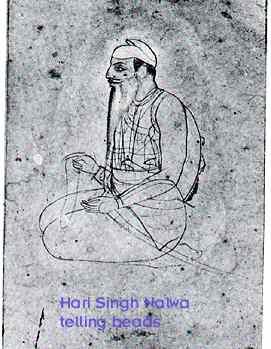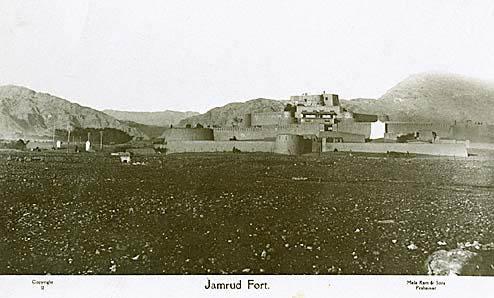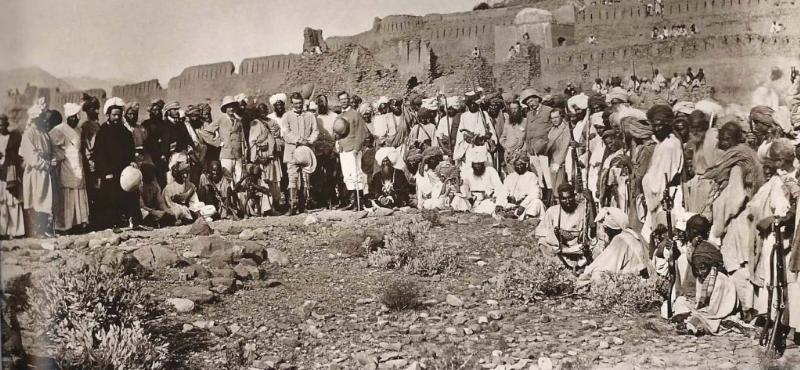The Nalwa Wall
I'll risk a bold statement here — India owes a lot to the Sikhs. If it were not for Maharaja Ranjit Singh, Hari Singh Nalwa and the thousands of Sikhs who died helping the Khalsa clear the Punjab and Jammu and Kashmir of Afganistani invaders and their Kingdoms, India and Pakistan would look a lot different on the map today for both would have not been part of either, but, rather a part of Afganistan.
The Nalwa Wall
The Nalwa Wall an historic ring of forts developed by Hari Sing Nalwa. For hundreds of years westerners had thundered through the passes of the Hindu Kush. Long befor Babar, the Afganis, Persians and then the Afganis again had come to India to rob it of its riches and people.
Under Maharaja Ranjit Singh who appointed Hari Singh Nalwa to take over the defence of the passes through which these invaders, murderers, scavengers and even conquerors came, a system of forts were established to once and for all but an end to these foreign invasions.
General Nalwa the greatest general of the Khalsa studied the situation and the terrain and established a ring of fort to preclude any futher invasions.
The Nortwestern defenses
Hari Singh Nalwa knew how to match the Sikh hatred by Afghans. He set up a very strong administration in the Peshawar valley. He levied a cess of rupees, four per house on the Yusafzais. This cess was to be collected in cash or in kind. For its realization personal household property could be appropriated. There was scarcely a village which was not burnt. In such awe were his visitations held that his name was used by mothers as a term of fright to hush their unruly children.(1)
It was prudently realized that although the spell of Afghan supremacy was broken, the region predominantly populated by turbulent and warlike Muhammadan tribes could not be securely held unless a large army was permanently stationed there. A force of twelve thousand was with Hari Singh Nalwa to quell any sign of turbulence and to collect the sizeable revenue. The terror of the name of the Khalsa resounded in the valley. Part of the city of Peshawar was burnt and the residence of the Barkzai governors at Bala Hissar was razed to the ground. Hari Singh Nalwa strengthened the Sikh position by garrisoning the frontier forts.(2)
The Ring of Frontier Forts
A Navigatible Satellite View of the Forts, currently only Jamrud is marked. Click here > [1] location of Peshawar and forts at Wikimapia.org
In order to consolidate the defence of the north-western frontier, Hari Singh Nalwa examined the topography of the Peshawar region. There were three rivers following from Afghanistan to Peshawar forming three water routes ( in this area river bed were also usefull as roadways especialy as the winters froze the rivers into highways of ice) as well as land routes. The highest tributary of the river Indus on the western side is the River Kabul. Kabul the capital of Afghanistan and Jallalabad are situated on the banks of this river. Nawshehra where a decisive battle had been fought in 1823 A.D. between the Afghans and Sikhs is also situated on the bank of this river.
The second important river is Barba River. It is a tributary of River Kabul and joins it from the southern side. Peshawar which the capital of the region is situated on its banks. The Swat River which is also a tributary of River Kabul joins it from the north. Hari Singh Nalwa decided to build forts in this terrain in order to check infiltration of, and the invasion of the Afghans on all these routes. The nearest mountainous pass to Peshawar is the Khaibar which is only nine miles from Peshawar.
- Michni fort.
On the previous occasions all important invaders had invaded India through Peshawar. Hari Singh Nalwa decided to construct forts on all these strategic points. On the bank of the River Kabul, Michni, a fort, was constructed and it was put under the command of Nichhatar Singh, (32) son of a well-known general Dhanna Singh malwai. In this fort were stationed 300 infantry men, 100 horsemen, 10 artillery men, two big and two small cannons.(3)
- Barha fort.
A strong fort was built also on the bank of the River Barha. Three hundred infantry, 100 cavalry, three cannon pieces were placed there and the required provisions were supplied. It was placed under Jhanda Singh Butalia.(4)
- Shankargarh
On the Swat river there was a strategic place where three routes met. These three routes were one from Kabul, another from Hashatnagar which was an Afghan settlement on the extreme north, and the third was Gandhav Pass a minor opening. Hari Singh constructed a fort here. It was named Shankargarh. Here there were stationed 500 infantry, 300 cavalry, 35 artillery men, two big and 10 small cannons. Lehna Singh Sandhanwalia, a well-known warrior was in command here.(5)
- Fatehgarh Sahib or Jamrud Fort
By far the most important route was through the Khaibar Pass which had been the traditional route for the invaders since times before man knew how to write. After surveying the entire area Hari Singh spotted a small mound on the eastern end of the Khaibar Pass which was a part of the nearby village of Jamrud. It had the remains of a small mud fort. Hari Singh decided to build a fort there. Necessary material was collected and a foundation of a very strong fort was laid on October 17, 1836.
Hari Singh Nalwa himself laid the first stones of the foundation of the fort after offering prayers. The masons and the labourers worked there continuously and they were able to finish this massive fort after a month and twenty-five days. Its walls were four yards thick at the base and 12 yards high. It was named Fatehgarh (Fort of Victory) Sahib.(6) Inside this fort were stationed 800 infantry, 200 cavalry, 80 artillery men, 10 big cannons and 12 small cannons. Looking at the site today and the old photos by Mela Ram & Sons, Peshawar one realizes what a remarkable feat it was to do so much work in so little time.
Maha Singh, a seasoned general, was appointed the commander of the fort. From day one the fort faced scarcity of water which was overcome by harnessing a nearby stream that was under the control of the Afridis. The Afridis were offered a jagir worth Rs. 122/ - in return for giving over control of the stream to the Sikhs. The lessons learned in Sikh history, noteably the siege of Anandpur, which every Sikh child grew up hearing, saw the Sikhs assuring an alternate supply of water within the fort by digging a big well.(7)
- Burj Hari Singh
A final important fort was built on the road leading to this fort linking Peshawar. It was just in the middle of the way between Jamrud and Peshawar.(8) It was named Burj (tower) Hari Singh after the General and 100 men were stationed there.
- Old forts like Attock, Khairabad, Shubkadar and Jehangir were repaired and Garrisoned with Sikhs. (9)
Interlocking System
This line of forts on the north-western side were linked by roads so that reinforcements could reach each fort in the time of crisis. Peshawar was strongly fortified and was linked with Attock by a line of towers erected at a distance of every two Kos.(10) This system of interlocked towers where men and horses could be stationed close enough to allow orders to pass quickly by horsemen or by smoke. Darius and Ghengis Khan and the Mughals had established this early form of Dak Khanas (mail service) and serais in which to stay safely in dangerous times. Hari Singh left little to chance.
Alarmed Afgans attack
All these defence measures of Hari Singh Nalwa alarmed the Afghans Dost Mohammad and Burkzai Chief of Kabul. The Afghans apprehended that their dangerous neighbours would soon make inroads beyond the formidable defence. Therefore, they resolved to put a stop to any further advance of the Sikhs into the tribal area. A force of 8,000 strong with 50 cannons under Akbar Khan and Abdul Samad Khan proceeded towards the Khaibar to dislodge the Sikhs from Jamrud. The cry of jehad swelled their ranks to 20,000 horse and foot. There are many tales of Hari Sing Nalwa's death each has a slight variations today there are at least two people claiming to be decendants, writing books on the General. More recent research mentions that oft mentioned villian of Sikh History, Maharaja Gulab Singh Dogra (not a Sikh) as having paid assasins to shoot the General. The facts are he was killed in the battle of Jamrud in 1837,(11) his death was concealed long enough for reinforcements to arrive and hold the fort and his memory is assured in Sikh and world history. Thus ended the life of a great general the terror of the Afghans.
Hari Singh Nalwa has been called:
- "…the bravest of the Sikhs Generals - the most dashing general - fertile in recourse and prompt in action".
- Edward Lincoln writes, “Hari Singh Nalwa carried the title of ‘Ney of Punjab’ and whose exploits in extending the Sikh dominion were hardly eclipsed by those of Maharaja Ranjit Singh himself”.(12) Marshall Ney was Napoleon I's Greatest General.
- Others have said with the weapons and materials of today , he could have conquered the world.
One thing is for sure He was a Warrior's Warrior.
References
- (1). Peshawar District, page 70, Quoted in Life and Times of Ranjit Singh. cit. op., p. 137.
- (2). Life and Times of Maharaja Ranjit Singh, cit.op., p. 136.
- (3)Ibid, page 245.
- (4)Ibid, p. 148.
- (5)Ibid, p. 242.
- (6)Ibid, p. 243.
- (7)Ibid, p. 243-44.
- (8)Sinha N.K. Ranjit, cit.op., p. 111.
- (9)Ibid, p. 111.
- (10)Chiefs and Families of Note in Punjab, Vol. II, Lahore, 1944, pages 87,89,90.
- (11)Gujranwala District Gazetter part A, Lahore, 1935, p. 29.
- (12)? Provide as found
Source
The Source Book On Sikhism
- Edited by Dr. S.S. Sodhi, Halifax, Canada
- Dr. J. S. Mann, Fullerton, California
- Produced by Sikh Sangat of North America
- Box 25111, Halifax, NS, Canada
- (902) 443-3269



